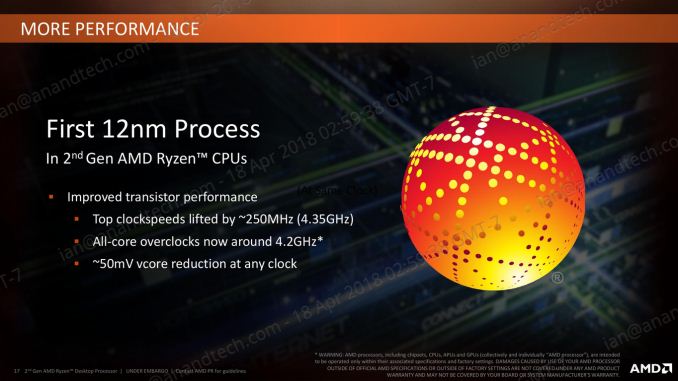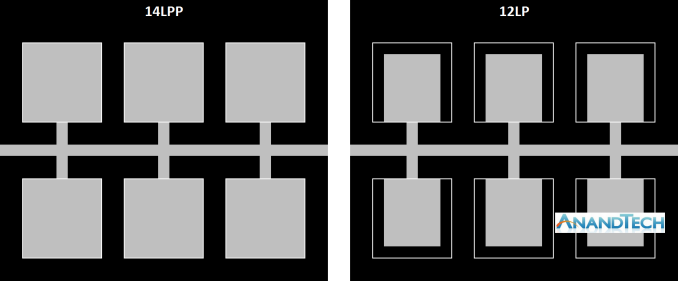The AMD 2nd Gen Ryzen Deep Dive: The 2700X, 2700, 2600X, and 2600 Tested
by Ian Cutress on April 19, 2018 9:00 AM ESTTalking 12nm and Zen+
One of the highlights of the Ryzen 2000-series launch is that these processors use GlobalFoundries’ 12LP manufacturing process, compared to the 14LPP process used for the first generation of Ryzen processors. Both AMD and GlobalFoundries have discussed the differences in the processes, however it is worth understanding that each company has different goals: AMD only needs to promote what helps its products, whereas GlobalFoundries is a semiconductor foundry with many clients and might promote ideal-scenario numbers. Earlier this year we were invited to GlobalFoundries Fab 8 in upstate New York to visit the clean room, and had a chance to interview Dr. Gary Patton, the CTO.
The Future of Silicon: An Exclusive Interview with Dr. Gary Patton, CTO of GlobalFoundries
In that interview, several interesting items came to light. First, that the CTO doesn’t necessarily have to care much about what certain processes are called: their customers know the performance of a given process regardless of the advertised ‘nm’ number based on the development tools given to them. Second, that 12LP is a series of minor tweaks to 14LPP, relating to performance bumps and improvements that come from a partial optical shrink and a slight change in manufacturing rules in the middle-line and back-end of the manufacturing process. In the past this might not have been so news worthy, however GF’s customers want to take advantage of the improved process.
Overall, GlobalFoundries has stated that its 12LP process offers a 10% performance improvement and a 15% circuit density improvement over 14LPP.
This has been interpreted in many ways, such as an extra 10% frequency at the same power, or lower power for the same frequency, and an opportunity to build smaller chips.
As part of today’s launch, AMD has clarified what the move to 12LP has meant for the Ryzen 2000-series:
- Top Clock Speeds lifted by ~250 MHz (~6%)
- All-core overclocks around 4.2 GHz
- ~50 mV core voltage reduction
AMD goes on to explain that at the same frequency, its new Ryzen 2000-series processors draw around 11% less power than the Ryzen 1000-series. The claims also state that this translates to +16% performance at the same power. These claims are a little muddled, as AMD has other new technologies in the 2000-series which will affect performance as well.
One interesting element is that although GF claims that there is a 15% density improvement, AMD is stating that these processors have the same die size and transistor count as the previous generation. Ultimately this seems in opposition to common sense – surely AMD would want to use smaller dies to get more chips per wafer?
Ultimately, the new processors are almost carbon copies of the old ones, both in terms of design and microarchitecture. AMD is calling the design of the cores as ‘Zen+’ to differentiate them to the previous generation ‘Zen’ design, and it mostly comes down to how the microarchitecture features are laid out on the silicon. When discussing with AMD, the best way to explain it is that some of the design of the key features has not moved – they just take up less area, leaving more dark silicon between other features.
Here is a very crude representation of features attached to a data path. On the left is the 14LPP design, and each of the six features has a specific size and connects to the bus. Between each of the features is the dark silicon – unused silicon that is either seen as useless, or can be used as a thermal buffer between high-energy parts. On the right is the representation of the 12LP design – each of the features have been reduced in size, putting more dark silicon between themselves (the white boxes show the original size of the feature). In this context, the number of transistors is the same, and the die size is the same. But if anything in the design was thermally limited by the close proximity of two features, there is now more distance between them such that they should interfere with each other less.
For reference, AMD lists the die-size of these new parts as 213mm2, containing 4.8 billion transistors, identical to the first generation silicon design. AMD confirmed that they are using 9T transistor libraries, also the same as the previous generation, although GlobalFoundries offers a 7.5T design as well.
So is Zen+ a New Microarchitecture, or Process Node Change?
Ultimately, nothing about most of the Zen+ physical design layout is new. Aside from the manufacturing process node change and likely minor adjustments, the rest of the adjustments are in firmware and support:
- Cache latency adjustments leading to +3% IPC
- Increased DRAM Frequency Support to DDR4-2933
- Better voltage/frequency curves, leading to +10% performance overall
- Better Boost Performance with Precision Boost 2
- Better Thermal Response with XFR2













545 Comments
View All Comments
risa2000 - Thursday, April 19, 2018 - link
With Ryzen 1x, while officially supporting DRAM 2666, people were usually aiming at running it at 3200, with significant speed improvement. Is Ryzen 2x also able to run at 3200 (or more) and will the impact of the speed difference be significant again?Total Meltdowner - Thursday, April 19, 2018 - link
No one can hit 3200 with ryzen 1 bro. Everyone is running that shit at 2666 tops. If you're lucky with RAM... 3000.Alistair - Thursday, April 19, 2018 - link
Common misconception. I have 3200 CAS 15 running with a 1700, have since the first bios update fixed the problem.Sungit - Thursday, April 19, 2018 - link
I'm running a 1700x 16GB (2x8GB) @ 3200 14-14-14-34, - just enabled XMP in bios. Cake.msroadkill612 - Friday, April 20, 2018 - link
Wow, what ram & mobo?risa2000 - Friday, April 20, 2018 - link
When I was looking at it half year ago, the memory support of Ryzen 1x was a mess, but there some boards and some memory modules (typically samsung "B" parts), which were able hit 3200 with good timing.The problem was more than 16 GB support and in general dual sided modules. But maybe the situation has changed since then. What was more concerning was the feeling of instability of the platform (i.e. some modules do not work with some chips/boards). I wonder if this prevails on Ryzen 2x.
What I also remember is that the memory throughput peaked at 3000/3200 depending on timing. It would be interesting to know if the same applies to Ryzen 2x.
T1beriu - Friday, April 20, 2018 - link
>No one can hit 3200 with ryzen 1 bro.Your mom can.
Sungit - Thursday, April 19, 2018 - link
The memory speed policy.. So in a nutshell, what we, your readers (the ones reading this article) are being told is - most of us don't know how to enter bios and click on XMP? Add me to the list that disagrees - especially as memory speed is critical to AMD infinity fabric, and zero chance of me running @ a slow 2933.. I did not bother reading the review past test bed setup as a result.ACE76 - Thursday, April 19, 2018 - link
The memory frequency has little impact... memory timings have a big impact...on x370, people were getting lower scores at 3200 and higher with loose timings vs running at 2933 with 14-14-14 timings.Sungit - Thursday, April 19, 2018 - link
What timings were used? Didn't see it spec'd. 16 perhaps? Like I mentioned in another post, I'm running a 1700x on a x370 taichi @ 3200 14-14-14-34 (simple XMP),and getting better than I could @ 2933. Regardless, the base/default speed/timings policy should be revisited.